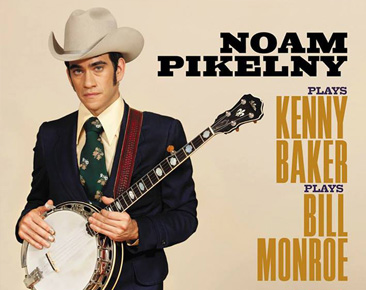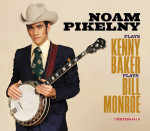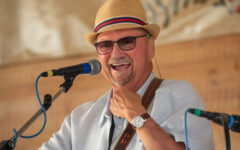
 You don’t have to be a banjo or fiddle nerd to love Noam Pikelny Plays Kenny Baker Plays Bill Monroe, but if you are… oh my!
You don’t have to be a banjo or fiddle nerd to love Noam Pikelny Plays Kenny Baker Plays Bill Monroe, but if you are… oh my!
One of the most admired five stringers in the world these days, noted for his discipline, vision and technical mastery, Noam set his sights on the more-than-iconic Kenny Baker Plays Bill Monroe album, which it would be fair to describe as the definitive statement of Monroe’s instrumental music.
The Punch Brothers banjo man had never recorded a strictly bluegrass record, and when it came time for him to start a new project earlier this year, he tells us that the idea took a circuitous route.
“The concept started as a one liner I texted to Ronnie McCoury. But over the last two years I had been re-upping my interest in traditional bluegrass – watching all these Crowe YouTube videos, reading his bio, and missing having the chance to play bluegrass. Still, there was no agenda to do a bluegrass project.
The way Punch Brothers works, we schedule everything well in advance, so we know when there will be time for solo projects. I knew I wanted to make a follow-up record to Beat The Devil and Carry A Rail this year, and it became clear that if I wanted it out in time, we’d have to record it by May. I had a few originals ready, but didn’t know whether I could write enough to fill it out.
I’ve never made a bluegrass record – leapfrogged that step in a banjo player’s career – and started thinking about that line I sent to Ronnie.”
That text had initially been meant as a joke, riffing on the redundancy of Noam Pikelny Plays Kenny Baker Plays Bill Monroe as an album title, but once he began to consider it more seriously, Pikelny saw that it could serve as both an interesting artistic challenge for him, and an entertaining musical adventure for listeners.
The plan he developed was to recreate the Baker album with a rhythm section of his peers, so he enlisted Stuart Duncan on fiddle, known as a serious student of Kenny’s playing, along with Ronnie McCoury, a master of the Monroe mandolin style, with Bryan Sutton on guitar and Mike Bub on bass.
As a test run of sorts, he started transcribing and working out Fiddler’s Pastime. It’s a demanding song even on the fiddle, with a shape-shifting structure and a tune heavily dependent on the sorts of slurs where a non-fretted string instrument excels. Taking it to the 5-string would clearly require some imagination and an openness to new ideas.
“I had never heard anyone play that song before on banjo – it’s so fiddlistic. But I knew that if I could get this to sound good on the banjo, I could make this concept work. It was a little bit of a struggle, but it was really rewarding once I got into it.”
 Obviously, since he went ahead with the project, Noam was pleased with what he was able to do with Fiddler’s Pastime. And well he should be. The finished recording strikes me as a masterpiece of re-imagining fiddle music for the banjo, a technical and artistic achievement of the highest level.
Obviously, since he went ahead with the project, Noam was pleased with what he was able to do with Fiddler’s Pastime. And well he should be. The finished recording strikes me as a masterpiece of re-imagining fiddle music for the banjo, a technical and artistic achievement of the highest level.
The same is true of the entire album, largely owing to the fidelity shown to the original Baker tracks. Noam’s are played in the same keys and octaves, at the same tempos, and arranged in the same order as on Kenny’s 1976 record. Even the CD cover is an homage to the Baker LP.
But the reason this one succeeds so completely is that Noam approached these tunes as distinct compositions, with attention given to faithful recreations of the fiddle melodies as opposed to banjo versions of familiar songs. He felt that a melodic style banjo album was a much more appropriate way to enter the bluegrass realm than a record of variations in the Earl Scruggs mode.
“Having Kenny’s music as a base forced me to look for new ways to find my voice on the banjo.
The beauty of these tunes is in the intricacies of the melodies. Without the melody, what’s really the point of these songs? A lot of players of my generation, myself included, can be guilty of not reaching in and become deeply involved with the melody.
I view this record as sort of a backlash against the way I might have played fiddle tunes a decade ago – or the way a lot of pickers do in the Nashville scene today.”







